| |
Winston
Churchill conned President Eisenhower into believeing that
he had the hydrogen bomb in order to get him to sign the 1958 US-UK Mutual Defense Agreement!! |
|
Even though the United States of Israel had a mutual defense agreement with Britain, Britannia did not even send a MEDICAL UNIT to Vietnam!!
Winston
Spencer Churchill was the son of King Edward VII "Edward the Caresser"
and Jennie "Sitting Bull" Jerome from Brooklyn. This was the second
time Winston Churchill deceived President Eisenhower....The first time was during
the 1956 Suez Canal Crisis.
Winston Spencer Churchill was
terribly disappointed that he was unable to provide cousin Adolf with an atomic
bomb before the Soviets entered Berlin. Thankfully, the British people rejected
Churchill after the war and he was out of office until 1950.
In 1954, he made his infamous
"Iron Curtain" speech in which he accused the Soviets of erecting
an iron curtain in Eastern Europe. The main reason why the Soviets stayed
in Eastern Europe was URANIUM. To catch up with the Pentagon and acquire their
own atomic bombs, they desperately needed access to the uranium mines in Czechoslovakia
and East Germany.
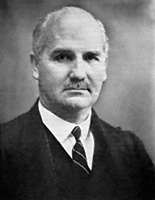
Frederick Lindemann
(1886–1957).
|
|
Frederick
Lindemann (Lord Cherwell) was a professor at Oxford University
and chief scientific adviser to Winston Churchill during WWII.
German
born Lindemann, "Baron Berlin," was the driving force
behind Adolf Hitler's
atomic bomb.
Lindemann
was also the driving force behind Churchill's atomic . . . and
fake hydrogen bomb. |
|
|
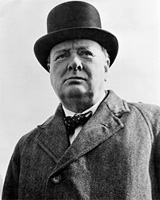
Winston Spencer Churchill
Prime Minister from '51 to '55.
|
Churchill was fanatical
about reversing the Russian victory over his cousin Adolf:
Privately, Churchill
suggested that America strike first, before it was too late. According to
FBI records, he urged Sen. Styles Bridges, a conservative Republican from
New Hampshire active in foreign affairs, to back a preemptory and devastating
attack on Moscow. "He [Churchill] pointed out
that if an atomic bomb could be dropped on the Kremlin wiping it out, it
would be a very easy problem to handle the balance of Russia, which would
be without direction," Bridges told the FBI. During a "private
conference with Churchill" while visiting Europe in the summer of 1947,
Bridges claimed the former prime minister had "stated that the only
salvation for the civilization of the world would be if the President of
the United States would declare Russia to be imperiling world peace and
attack Russia." If this wasn't done, according to the FBI report, Churchill
predicted "Russia will attack the United States in the next two or
three years when she gets the atomic bomb and civilization will be wiped
out or set back many years."
(Maier, When Lions Roar: the Churchills and the Kennedys, p. 453).
Churchill knew that the
United States did not do "Pearl Harbors" like cousin Adolf and his
Japanese allies, and would never strike first. That was the main reason why
Churchill decided that he had to have an independent atomic first strike force.
The 1946
McMahon Act restricted all foreign access to U.S. nuclear technology!!
In 1946, the Atomic Energy
Act transferred the Manhattan Project from the military to the "civilian"
Atomic Energy Commission (AEC).
The Atomic Energy Act
was also called "The McMahon Act" because it was sponsored by Brien
McMahon, a U.S. senator from Connecticut. Attached
to the Bill was a rider which totally restricted foreign access to Pentagon
nuclear technology. The Act was primarily aimed at the Soviet Union, as general
Groves had said that the atomic bomb was built "to restrain the Soviets."
Additionally, all the
patents for the creation of the atomic bomb were now the property of the Atomic
Energy Commission:
Truman
cast aside the Quebec Agreement and went along with the consensus in Washington
that the United States should work alone on nuclear energy. On 1 August 1946,
he signed the McMahon Act, which made it illegal for any American to share
nuclear information with any other country, signalling that the United States
was now supremely dominant in the nuclear field. Britain was left to its own
devices. On Capitol Hill, the British diplomat Roger Makin–the
civil servant most familiar with Tube Alloys–brandished
copies in Washington of the Quebec Agreement an aide-mémoire signed by Churchill
and Roosevelt, but the American lawmakers were unimpressed. As Makins later
recalled, 'They were very weak documents, and they had no legislative backing'.
Attlee complained about the passing of the Act in a letter to Truman, but
did not receive a reply and let the matter drop. (Farmelo,
Churchill's Bomb, p. 321).
20 British
scientists had worked at Los Alamos but their main job was to act as spies
and pass along information to Hitler on the progress of the Bomb. General Leslie
(Joy) Groves severely restricted access to the Hanford, Washington, plutonium
production reactor.
Left out in the cold by
the McMahon Act, Churchill decided to go it alone. In September 1947, a colossal
construction program began at Windscale in the Northwest of England. The purpose
of the construction was to build 2 nuclear piles that would produce plutonium
for his atomic bomb:
Work began there in
September 1947. It was a huge construction job and at its peak the workforce
totalled nearly 5000 men, with over 300 architects, engineers and surveyors.
At first it was hard to get labour in this remote area, but high wages and
the opportunity for almost unlimited overtime soon attracted workers to
'the gold coast'. Construction work went badly for a while, but then improved
so that the design work at Risley could hardly keep pace. (Arnold, Windscale
1957: Anatomy of a Nuclear Accident, p. 11).
The best and brightest
nuclear physicists and engineers from all over Britain and the Empire were
summoned to Windscale to work on the massive project. No expense was spared
as the astronomically expensive reactors were constructed.
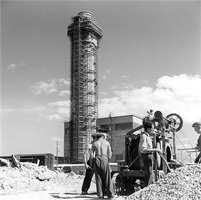
Workmen constructing the
massive piles.
|
|
Cumbria,
in Northwest Britain, was chosen for the site of the first plutonium
producing reactors.
The
site was chosen for its remoteness and the fact that it was close
to Scotland.
By
that time, most atomic scientists knew how deadly even small amounts
of radiation can be.
|
|
|
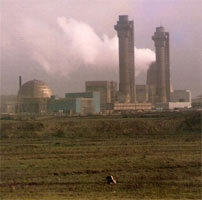
The 2 Winscale piles were
completed in 1951.
|
Supervised
by "Baron Berlin," Christopher Hinton
was responsible for the design and construction of most of Britain's major
nuclear power plants, including Windscale, Capenhurst, Springfields and Dounreay.
In 1957, Hinton became the first chairman of the Central Electricity Generating
Board. He retired in 1964.
Alarmingly, giant fans
were used to cool the atomic piles and prevent an explosion. The Pentagon
used water to cool their plutonium producing reactor at Handford, Washington.
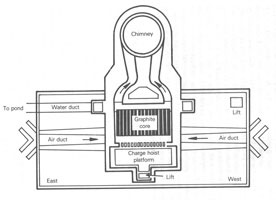
A plan of the reactor.
|
|
Alarmingly,
the red hot core was cooled by a novel method: giant fans.
No British scientists had worked at Hanford in Washington
state, so they were clueless about constructing nuclear reactors.
The
French
successfully cooled their reactors with carbon dioxide gas.
|
|
|
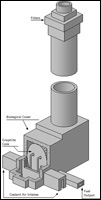
Cutaway diagram of
Windscale reactor.
|
Fan cooling the reactor
cores was a sure recipe for disaster.
Churchill didn't
have the slightest care for safety: He wanted his scientists and engineers
to produce his atomic bomb in the shortest possible time.
Churchill's atomic
bomb was obsolete 22 days after testing!!
Operation Hurricane was
the test of the first British atomic device, on October 3, 1952. A plutonium
implosion device was detonated in the lagoon between the Montebello Islands,
Western Australia, just over three years after the Soviet Union detonated
a similar plutonium implosion device, in September 1949.

HMS Plym before the
nuclear explosion.
|
|
The
first test of a British atomic bomb took place on October 3, 1952.
The
device was placed aboard a ship and exploded between the Montebello
Islands, in Western Australia.
Coincidently,
the first U,S. atomic explosion took place in a ship moored in
Port Chicago,
San Francisco.
|
|
|
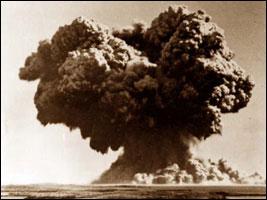
The first British atomic bomb explosion
was in Western Australia.
|
The explosion was about
25 kilotons of TNT–bigger than both devices exploded at Hiroshima and
Nagasaki. It was the first time that the Aussies were exposed to deadly fallout
radiation.
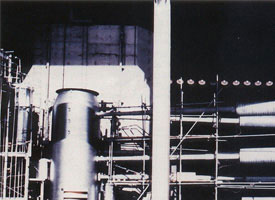
The first H-bomb (hell bomb)
was a massive monster. |
|
The
first Pentagon hydrogen bomb test was called "Ivy Mike"
and took place in the "Pacific" Ocean on November 1,
1952.
Its
yield was 10.4 megatons (450 times more powerful than the Nagasaki
bomb).
The
H-bomb was far, far too big to place on a ship or airplane. |
|
|
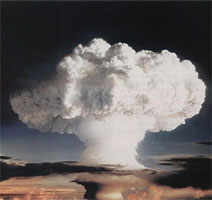
The first hydrogen bomb test
was called "Ivy Mike." |
When Churchill received
the news he was literally sick. Producing the first atomic bomb had put a
great strain on the resources of the nation but that bomb was a child's toy
compared to the "Super. " In the atomic age, size did matter, and
only great nations like the United States and the Soviet Union had the resources
to build hydrogen bombs.
Senator
McMahon died shortly after Churchill's 1952 U.S. visit!!
With the exploding of
the "Super," the stakes were indeed raised. Churchill realized that
he could not complete on that level with a vast nation like the United States.
In January 5, 1952, Churchill
visited Washington City, accompanied by his protégé, Sir Anthony Eden, and
"Baron Berlin,"
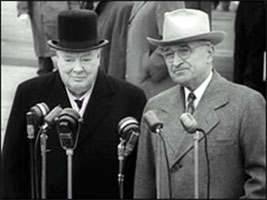
President Truman greeting Winston
Churchill at the National Airport.
|
|
The
real reason for his visit was to try and make senator Brien McMahon
repeal the McMahon Act.
Churchill
summonsed the senator to the British Embassy and berated him for
the Act.
The
48-year-old senator refused to be browbeat or bribed, so on July
28, 1952, he died suddenly of "cancer." |
|
|
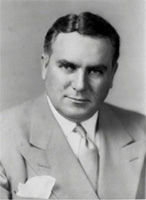
Senator Brien McMahon
(1903–1952).
|
Here is an account of
that visit by a British lord who was present:
Four
days after he arrived in Washington, his only American guest for lunch at
the British Embassy was Senator Brien McMahon, who had done more than anyone
else to terminate Anglo-American nuclear cooperation. Churchill had corresponded
with the Senator a few years before but, out of ignorance or discretion, had
not raised the subject of his Act. With the culprit now in front of him, the
Prime Minister examined him like a prosecutor: he sent for a copy of the Quebec
Agreement and handed it to McMahon, who read it. According to fellow guest
Lord Moran, Churchill declared that Britain 'has been grossly deceived' and
that there had been 'a breach of faith.' McMahon replied with the words the
Prime Minister wanted to hear: 'If we had known this, the Act would not have
been passed.' Attlee never said a word. Churchill's suspicions had been vindicated–he
could now blame the rupture in Anglo-American nuclear relations entirely on
Attlee. (Farmelo, Churchill's Bomb, p. 386).
That account, written
by Churchill's friend, never revealed what really took place at that momentous
meeting between the cunning Churchill and an honest U.S. senator.
Senator Brien
McMahon was a presidential candidate and a man of peace. Poisoning a U.S. senator
was an act of war by Churchill. If general Jackson had been President, he would
have challenged Churchill to a duel!!
It is very strange that
no biographer has taken the time to write a biography of that great man who
insisted that atomic energy should be under civilian control.
In 1953, Winston Churchill
was knighted by Queen Elizabeth II. It was a "thank you" from the
queen for appointing her to the throne.
Churchill
ordered that 2 more reactors be quickly built at Windscale!!
Churchill arrived back
from Washington City bitterly disappointed that President Truman was not about
to give him access to atomic or hydrogen bomb technology. Consequently, he
ordered a crash program to develop the "Super." That entailed significantly
more plutonium and an isotope of hydrogen called tritium. Tritium was not
produced in regular nuclear reactors such as Windscale.
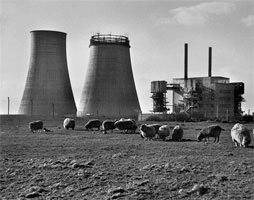
Calder Hall nuclear reactors. Notice the
radioactive sheep in the foreground.
|
|
On
October 17, 1956, Queen Elizabeth II opened 2 new reactors near
Windscale.
Ostensibly,
the reactors were built to produce electricity for the National
Grid.
In
reality, the reactors were built to produce plutonium for Churchill's
"hydrogen bomb."
|
|
|
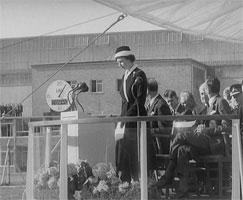
Queen Elizabeth II
opening
Calder Hall nuclear power station.
|
Calder Hall was hailed
as the world's first civilian nuclear power station. From that time onward,
generating electricity was used as a smokescreen to hide the production of
deadly plutonium. Nuclear power plants do not generate electricity. They just
boil water to produce steam to turn a turbine. It's a deadly way to boil water
. . . like cutting butter with a chainsaw.
Neither Windscale or Calder
Hall reactors produced tritium which is a vital element in a hydrogen bomb.
Churchill's
"hydrogen bomb" was a fake or look-alike!!
Churchill's motto was
"if you can't make it . . . FAKE it." He never got further than
the atomic bomb because Britain did not have the industrial and financial
resources to produce a hydrogen bomb.
Sir Willaim Penney is
called the "Father of the British atomic bomb". He worked at Los
Alamos so he was thoroughly familiar with the design of the Bomb.
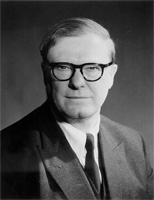
Sir William Penney
(1909–1991).
|
|
Physicist
Sir William Penney was the driving force behind Britain's atomic
bomb.
In
1954, Churchill demanded that he produce the "Super,"
without giving him the materials.
A
vital ingredient, called tritium, was not available to
him at that time. |
|
|
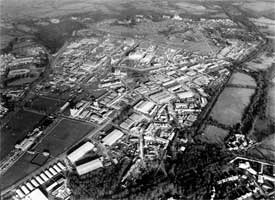
The atomic bombs
were produced in
Albermaston, in Southeast Britain.
|
The imperious Churchill's
command to Penney was like Pharaoh's command to the Israelites "make
bricks without straw."
A British spy named John
Ward, "teaching" at Princeton University, was able to obtain a diagram
of the top secret Ulam-Teller hydrogen bomb configuration. That was little
help to Penney without tritium. Tritium is an isotope of hydrogen and requires
a huge expensive plant to produce. France
could not obtain tritium for her first hydrogen bomb until 1967.
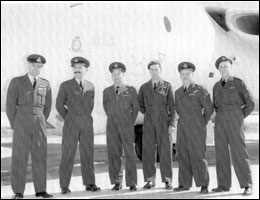
Crew of the Valiant bomber (L to R) Captain Hubbard, Bob Beeson, Ted
Laraway, Eric Hood, Alan Washbrook and Bill Caple.
|
|
Group
Captain Kenneth Hubbard commanded Operation Grapple that
dropped the atomic bombs aka hydrogen bombs.
From
1957 to 58, Captain
Hubbard dropped a total of 7 "thermonuclear" devices.
It
was all just thermonuclear
bluff to con President Eisenhower into signing the treaty.
|
|
|
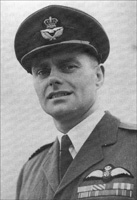
Group Captain Kenneth Hubbard
(1920–2004).
|
Amazingly, according to
historian Lorna Arnold, Lewis Strauss offered Churchill the use of Eniwetok
Atoll for free:
About this time the
chairman of the United States Atomic Energy Commission, Admiral Lewis Strauss,
spoke informally to the British Ambassador in Washington about possible
British use of the American base at Eniwetok and, rather surprisingly, indicated
that Britain would not have to pay for it. However, the British government
did not favour the suggestion, because ideas on the conduct of the tests
were not yet sufficiently advanced for them to put forward any firm proposals,
and the search for a new range continued. In early May 1955 the Foreign
Secretary, Selwyn Lloyd, after consulting departments, concluded that the
Kermadec Islands in the South Pacific, 600 miles north-east of New Zealand,
would be suitable. As the islands were New Zealand territory, he advised
the Prime Minister, Anthony Eden, to ask Sydney Holland, the New Zealand
Prime Minister, personally for his help. Holland refused, despite detailed
assurances about the safety precautions, and much emphasis on the importance
of the tests for Britain and the defence of the Commonwealth. Holland feared
an unfavourable public reaction if such a decision became known in the run-up
to New Zealand's 1957 general election. But for the next few months he and
his colleagues were under much pressure from the British government to change
their minds.(Arnold, Britain and the H-Bomb, p.96).
The Kiwis refused to let
Churchill test his deadly bombs anywhere near their country, so a remote spot
named Christmas Island was chosen.
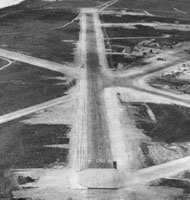
Hastily improvised bomber
airfield on Christmas Island.
|
|
The
New Zealand prime minister refused to let Churchill test his deadly
bombs anywhere near his country, so a remote spot named Christmas
Island was chosen.
All
the tests were top secret and only Churchill's sycophants
were allowed to observe the tests.
The
Pentagon wasn't fooled, but it was enough to con President Eisenhower
into signing the deadly treaty. |
|
|
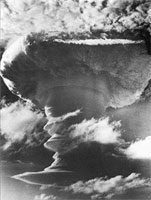
Operation Grapple
mushroom cloud.
|
None of the British
atomic bomb physicists ever claimed to be the "Father of the H-Bomb,"
because they knew the TRUTH:
Unlike
Teller, Ulam or Sakharov, none of the British weaponeers–neither Penney
nor Cook, nor any of the Aldermaston scientists–wrote personal accounts
of their work. Though Penney has been called 'the father of the H-bomb,'
he never made any such claim himself and would certainly have deprecated
it.
Few contemporary documents give any consecutive account of the nuclear weapon
programmes (one account is reproduced at Appendix 3), and they are brief
and impersonal. Exactly how and when Aldermaston discovered the three essential
ideas of the H-bomb is still something of a mystery. In trying to elucidate
it, we have had to depend on collating many miscellaneous documents, often
scrappy, sometimes ambiguous, frequently unsigned and undated and barely
identifiable. Fortunately, we were able to talk to several participants
who were close to the origins of the British H-bomb, though, regrettably,
not to four who were at the heart of it–Penney, Cook, Hulme and Roberts.
(Arnold, Britain and the H-Bomb, p. 224).
After
the treaty was signed in 1958, all of the people involved in the Mickey
Mouse "hydrogen bomb" tests vanished into obscurity.
Windscale
(Sellafield) was the world's first nuclear disaster!!
The Windscale meltdown
in October 1957 had the dubious distinction of being the world's first nuclear
disaster. It was soon followed by the 1979 Three Mile Island, in Pennsylvania,
and the 1986 nuclear disaster in Chernoby, UKraine.
The strain of producing
so much plutonium for Churchill's"hydrogen bombs" finally led
to the world's first nuclear disaster.
Under the direction
of Baron Berlin, Christopher Hinton was in charge of the construction of
the Windscale reactors.
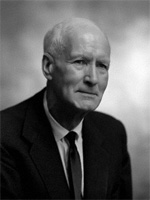
Christopher Hinton
(1901–1983).
|
|
The
October 1957 Windscale
fire was the world's first nuclear disaster.
Christopher
Hinton supervised the building of Windscale but he did not visit
Windscale during the disaster.
General
manager Thomas Tuohy was the HERO who ignored the deadly radiation
in order to save the lives of millions of people. |
|
|
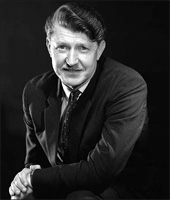
Thomas Tuohy (1917–2008), was
the Hero who saved Windscale.
|
The Windscale fire of
October 1957 happened at the worst possible time for Churchill. The deadly
radiation that he had planned for the Soviet Union was now falling on his
own country.
Additionally, there
was more bad news for Churchill when the Soviets launched Spuntik 1
into orbit that very same month.

Map of the radiation fallout
from Windscale.
|
|
The
fire was so bad that firemen had to be conscripted from the
local cinema to fight the blaze.
Only
turning off the fans and dousing the core with water saved the
reactors from an atomic explosion.
|
|
|
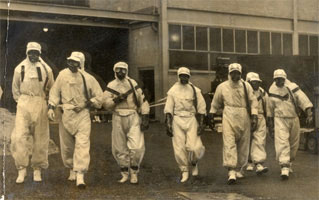
Nuclear firefighters in protective clothing ready
to tackle the raging inferno in the reactor.
|
As a last resort, Thomas Tuohy gave the order to douse the
core with water:
Water was a last resort.
Putting water on burning graphite and metal might cause an explosive mixture
of carbon monoxide and hydrogen with air, but finally–as Davey,
Ross and Tuohy had agreed earlier–the risk had to be taken. Preparations
were made to bring water supplies to the charge face. Equipment had to
be quickly and ingeniously improvised, for there were no water connections
available. There were arrangements for firefighting elsewhere, but in
the pile area it had been a rule that water must be kept out of the pile
building for fear of a criticality accident with the enriched uranium
cartridges. Moreover, it was assumed that dowsing a channel fire with
water would contaminate the pile so as to make it inoperable and destroy
it as a production unit. It had been regarded as axiomatic that any fire
would start in a single channel, that the radioactivity released would
be quickly detected by the BCDG, and that the burning fuel element or
elements would be discharged before the fire could spread. But the paradox
was that the only way to cool the pile was by blowing air through it;
yet if a fire had begun to take hold, the coolant air would fan the fire,
not quench it. (Arnold, Windscale 1957: Anatomy of a Nuclear Accident,
p. 51).
It seems that saving
the reactor at all costs was given priority over the millions of lives that
were imperiled by the radiation. The water did destroy the graphite core
but eventually the fire was extinguished.
The
Cuban Missile Crisis was Winston Churchill's swan song!!
Incredibly, the Windscale
disaster had far reaching geopolitical implications. Churchill knew by then
that he would never have an independent nuclear strike force to attack the
Soviet Union. He also knew that the United States did not do "Pearl
Harbors" or attack without a declaration of war.
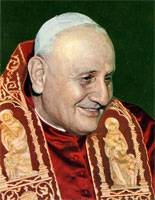
Pope John XXIII.
Pope from Oct. 28, '58 to June 3,'63.
|
| |
In October
1958, austere, imperious Pope Pius XII was given the poison
cup and sent to St. Peter.
A friendly,
smiling Pope John XXIII eased the way for John F. Kennedy
into the White House.
In 1959,
British Secret Service agent Fidel Castro became prime minister
of Cuba.
|
|
|
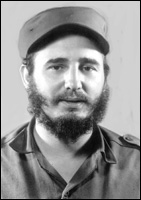 Fidel Castro (b.
1926).
Fidel Castro (b.
1926).
|
Pope Pius XII had to
"retire" in order for JFK to enter the White House. JFK needed
the black vote but Pope Pius XII requested
that general Mark Clark not use black troops during the 1944 U.S. occupation
of Rome.
British Secret Service
agent Nikita Khrushchev was already premier of the Soviet Union when "Communist"
Fidel Castro came to power in 1959. Ukrainian Nikita Khrushchev came to
power upon the sudden death of Joseph Stalin in 1953.

John Fitzgerald Kennedy
(1917–1963).
|
| |
The "Camelot
legend" was born with the inauguration of President
Kennedy in January 1961.
The 1958
US–UK Mutual Defense Agreement gave Churchill his longed for
access to hydrogen bombs.
Uncle
Sam became "Uncle SAP" with that treaty because
it was assumed that Britain had its own hydrogen bombs.
|
|
|
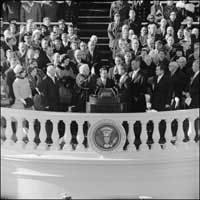
President Kennedy's inauguration
on Jan. 20, 1961. |
HMS
Dreadnought–the
first British nuclear submarine–was
a virtual copy of the USS Nautilus which was launched on January
21, 1954, in New London, Connecticut. Ironically, Connecticut was the home
state of the murdered senator Brien McMahon.
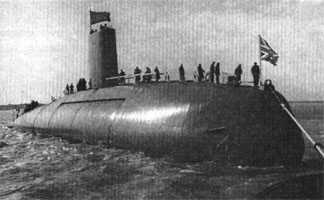
HMS Dreadnought was the first British nuclear submarine
based on the Rickover design and armed with hydrogen bombs.
|
|
HMS
Dreadnought, armed
with U.S. made sea launched nuclear missiles, was a carbon copy
of the USS Nautilus.
Vulcan
bombers were equipped with U.S. made hydrogen bombs.
|
|
|
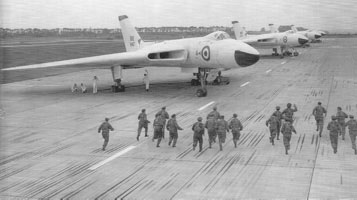
Vulcan bombers armed with U.S. made hydrogen
bombs at RAF Scampton,
Lincolnshire.
|
Beginning in the summer
of 1962, "Communist" Nikita Khrushchev began secretly shipping
"nuclear missiles" to Cuba via the British controlled Straits
of Gibraltar. Khrushchev was not even Russian, he was a "fake Jew"
from UKraine, and most of his soldiers in Cuba were UKrainians.
Winston
Churchill knew that the U.S. did not do "Pearl Harbors" like cousin
Adolf or Emperor Hirohito. That
was the reason for the false flag Cuban Missile Crisis.
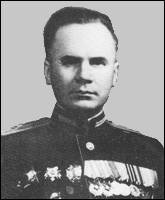
Colonel
Oleg Penkovsky
(1919–1963).
|
|
Colonel
Oleg Penkovsky–the Russian Guy Fawkes–was supposed to decapitate
the Russian High Command before Churchill's Vulcan bombers joined
Curtis LeMay's.
Greville
Wynne was Penkovsky's liaison with MI6.
In
his memoirs, written in 1981, Wynne said that Penkovsky had
a top secret visit with Queen Elizabeth and President Kennedy,
who thanked him in advance for the great work he was
about to do!! |
|
|
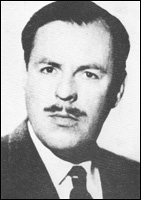
MI6 Greville Wynne
(1919–1990).
|
On the very day that
President Kennedy made his "full retaliatory response" speech,
Penkovsky was arrested. Moscow was about to explode like the English Parliament
building and it wasn't even Guy Fawkes Day yet!!
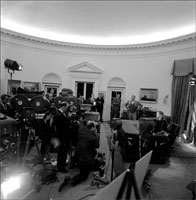
President
Kennedy preparing for
his dramatic address to the nation.
|
| |
On
the very day (October 22) that President Kennedy made his "full
retaliatory response" speech, Penkovsky's plot was uncovered.
The
arrest of the Russian Guy Fawkes caused
panic at Whitehall and the Pentagon as they now faced
the prospect of a horrible death by cobalt hydrogen bomb radiation. |
|
|
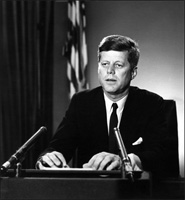
President Kennedy making his "full retaliatory response"
speech. |
We can thank our great
JEHOVAH that Churchill's mad scheme to nuke the Soviet Union was exposed.
Mankind was saved from the most terrible fate since the great Flood of Noah.
Churchill went to meet
his Maker on January 24, 1965. His funeral was the largest in the history
of the world up to that time. Even though he was responsible for 2 world
wars, and quite possibly Armageddon, the mighty men of the earth
gathered in London to mourn his death.
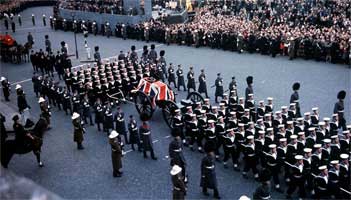
Funeral
cortege of Sir Winston Churchill.
|
|
Mighty
man Sir Winston Churchill died a failure because Mother
Russia has survived his Communists, cousin Adolf, the Cold War,
and is still the guardian of the free world.
Albeit
with an MI6 "Putin" as President!! |
|
|
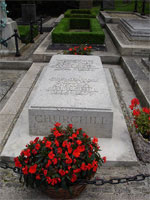
Churchill's grave at St Martin's
Church, Bladon, Oxfordshire, |
Winston Churchill's
body awaits the Last Trumpet at St. Martin's Church in Bladon near Woodstock,
Oxfordshire, England. A man of war all his life, he now has to face the
Prince of Peace on the Last Day. Here is what the mighty men of
the earth will be doing on that terrible day:
The great
day of JEHOVAH is near, it is near, and hasteth quickly, even the voice
of the day of JEHOVAH: the mighty man shall cry there
bitterly (Zephaniah 1:14).
Vital
links
References
Arnold,
Lorna, Windscale 1957: Anatomy of a Nuclear Accident. St. Martin's
Press, New York, 1992.
Arnold, Lorna.
Britain and the H-Bomb. Palgrave Macmillan. Hampshire, UK, 2001.
Birkenhead,
Earl of. The professor and the Prime Minister: The official life
of Professor F.A. Lindemann, Viscount Cherwell. Houghton Mifflin
Co., Boston, 1962.
Fort,
Adrian, Prof: The Life of Frederick Lindemann, Jonathan Cape,
London, 2003.
Farmelo,
Graham. Churchill's Bomb. Basic Books, New York, 2013.
Hubbard,
Kenneth, & Simmons, Michael. Dropping Britain's First H-Bomb:
The Story of Operation Grapple 1957/58. Pen & Sword Aviation,
Barnsley, South Yorkshire, Uk, 2008.
Hennessy,
Peter. The Secret State: Churchill and the Cold War. Penguin
Press, London, UK, 2002.
Wynne, Greville.
The Man From Odessa: The Secret Career of a British Agent. Granada
Publishing Co., London, UK, 1981.
Copyright
© 2015 by Patrick
Scrivener
Back
to Main Menu



































